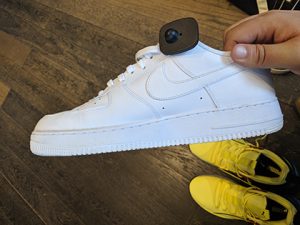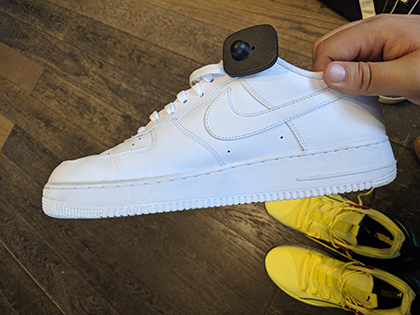Now, I wouldn’t call myself a sneakerhead by any definition of the phrase, but certain shoes will forever pique my interest. The classic Jordan 1 silhouette has captivated me since I saw Space Jam as a kid and became entranced with the MJ legend. For decades after that seed of appreciation was planted in my head as a child, I never thought twice about sneaker style. I was more of a chukka guy, to be honest.

Fast forward to Summer 2019: I’m at a thrift store in Greenpoint, Brooklyn. I’m browsing the shelves for a rare size 13 shoe that would be worth salvaging. I come across a pristine pair of Air Force Ones for $30. At that moment, my limited interests in sneakers burst open to include the entire Nike roster.
Fast forward a few more years: I’m a first-year law student reading about a devilishly controversial case involving another famous Nike sneaker.
Old Town Roads, Unholy Footwear
In early 2021, viral music sensation and provocateur, Lil Nas X made headlines for a shoe he planned to sell. The shoes had a swooping silhouette, a raised heel, and a bronze pentagram charm. The cherry on top? The shoes allegedly contained real human blood. Dubbed the ‘Satan Shoes’, Mr. Nas X naturally only planned to issue 666 pairs of the shoe. These were Nike Air Max shoes that Mr. Nas X was selling. But Nike wasn’t the one making or issuing the shoe. What was going on? I smelled an intellectual property issue at play.
MSCHF Managed
Lil Nas X created his ‘Satan Shoes’ by altering Nike Air Max 97s after purchase. He collaborated with a New York-based art collective called MSCHF to design and produce the shoes. To make them, MSCHF essentially bought a large amount of sneakers from Nike and to modified each one. Afterwards, they sold the modified Nike shoe as the “Satan Shoe.”
Buying, modifying, and reselling shoes like this isn’t new. There is a healthy market for customized shoes from artists who put their own twists on famous silhouettes. The Air Force One is a common shoe for such a market due to their comfort, plain white leather, and appealing silhouette. Legally, this type of secondhand sale is possible through something called the first sale doctrine, but we’re not going to get into that. The star of the show is the ‘Satan Shoe’ controversy!
Panic Attack
What’s unique about this controversy is that Nike doesn’t typically sue artists who modify and resell their shoes. Here, Nike was prompted by outrage to sue Mr. Nas X and MSCHF as a way of denying involvement and distancing themselves from the shoe. Reminiscent of the satanic panic from the 80s, those made uncomfy by satanic themes littered the internet with angry tirades, tweets, and threats of boycott, aimed at Nike.
While Nike had to deal with this PR nightmare, they didn’t actually have any role in the creation of this luciferin footwear. Having customers associate these satanic shoes with their brand had the potential to be economically harmful in the long term. Nike needed to preserve their brand image. Consequently, Nike brought suit alleging trademark dilution and infringement.
Metal isn’t the only thing that tarnishes
To understand Nike’s basis for suing, let’s learn a little bit about trademarks. A trademark, or “mark,” can be a word, phrase, symbol, or design that is used in commerce to identify a good or service. It distinguishes a product from others in the mind of the consumer. Fundamentally, trademark law prevents unauthorized uses of the same or even similar mark on goods if it would cause a consumer confusion about who is making or selling a product. Unauthorized use of a mark that confuses consumers is referred to as trademark infringement.
In addition, because the effectiveness of a mark is based on how a customer associates it with a company and its product, anything that disrupts or damages that association in the mind of the consumer can be problematic for the company. This disruption is called trademark dilution. Dilution refers to the weakening of the association the consumer has made of the product with the mark. The mark that’s being diluted must be famous enough that people can even make such associations. Dilution can be broken down into two categories, blurring and tarnishment.
Dilution by blurring occurs when the distinctiveness of a famous mark, or how well the mark distinguishes the product from others, is impaired. Consumers end up having a weaker association between a mark and the mark owner due to the use of another similar mark. For example, imagine a new company makes and sells a phone called the myPhone. This could present an issue for Apple who sells the iPhone. People might start to think that Apple is associated with the myPhone given how similar the names are.
Dilution by tarnishment occurs when the famous mark suffers reputational harm through association with a product of shoddy or inferior quality, or a mark that is distasteful or unsavory. Nike’s fear, in this case, was likely that their trademarks associated with their Air Max shoe would become associated with the ‘unsavory’ satanic shoe, thus tarnishing the reputation of their mark.
Nike’s Trademarks

Nike as a company has a massive catalogue of trademarks. All the logos, words, and phrases that are stamped on their merchandise and advertisements that distinguish their product such as “just do it” fit the definition. With respect to the Air Max, the shoe is stamped with a good smattering of these marks. Most prominently among these are the Nike swoosh and the actual word “Nike.” These marks were not removed from the shoe after being modified. The Swoosh is clearly visible on the Satan shoe, and it was featured prominently in advertisements for it. So, anyone who looks at the Satan shoe and didn’t know that it was modified, might assume that the Satan shoes were made directly by Nike. The ensuing backlash Nike faced suggested the public assumed just that. Nike cited such backlash to support their claims of dilution by tarnishment.
Sale and Resolution
The shoes sold out immediately despite the +$1000 price tag. Even I, with my poor impulse control when it comes to purchasing novelties like this, did not entertain such a cost (RE: my last article: I bought the cards). After a judge granted Nike’s injunction to stop the sale of the shoes, the suit quickly resolved and the case was settled.
Additionally, Nike managed to repair any reputational damage. They successfully distanced themselves from the shoe by issuing public statements, by publicizing the filing of the suit, and by getting MSCHF to agree to issue a voluntary recall of the Satan shoe to any customer who thought they were getting a shoe sold directly by Nike.
So, what’s the ultimate outcome? Nike was no longer in the public hot seat. Lil Nas X successfully performed in his role as a provocateur. MSCHF made an artistic statement by taking on this project. Everyone wins and they all lived happily ever after.
Louay Meroueh
Co-Technical Editor for the Loyola Intellectual Property Law Blog “IP Bytes”
Director of Programming for the Intellectual Property Law Society
Technical Manager for the Rule of Law Institute at Loyola
Competitor on the Fall 2021 Negotiation

